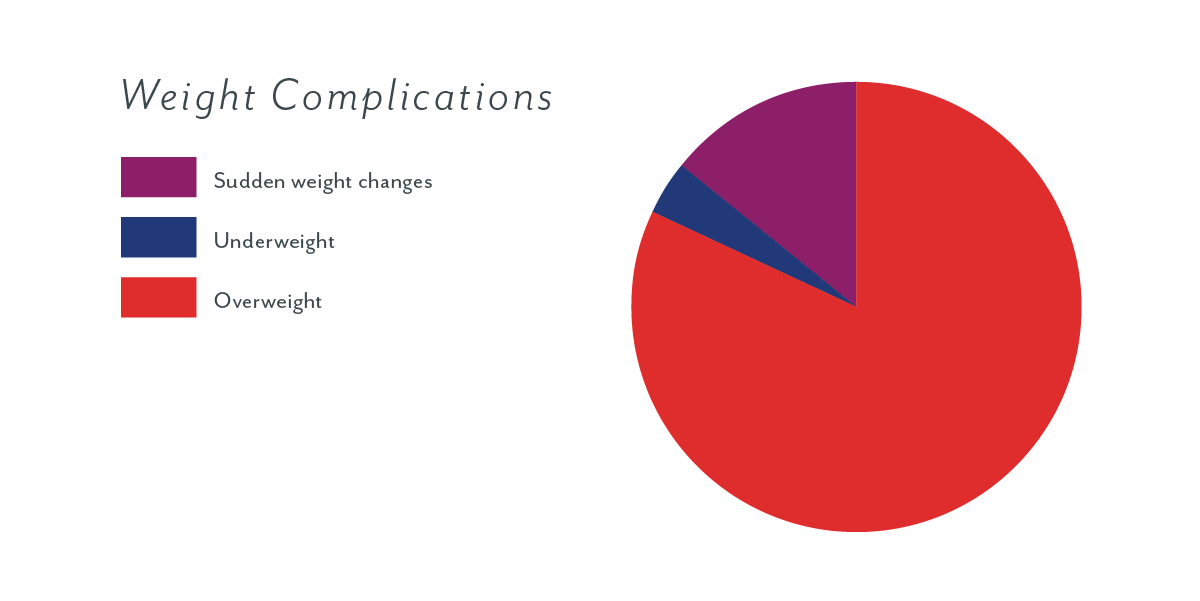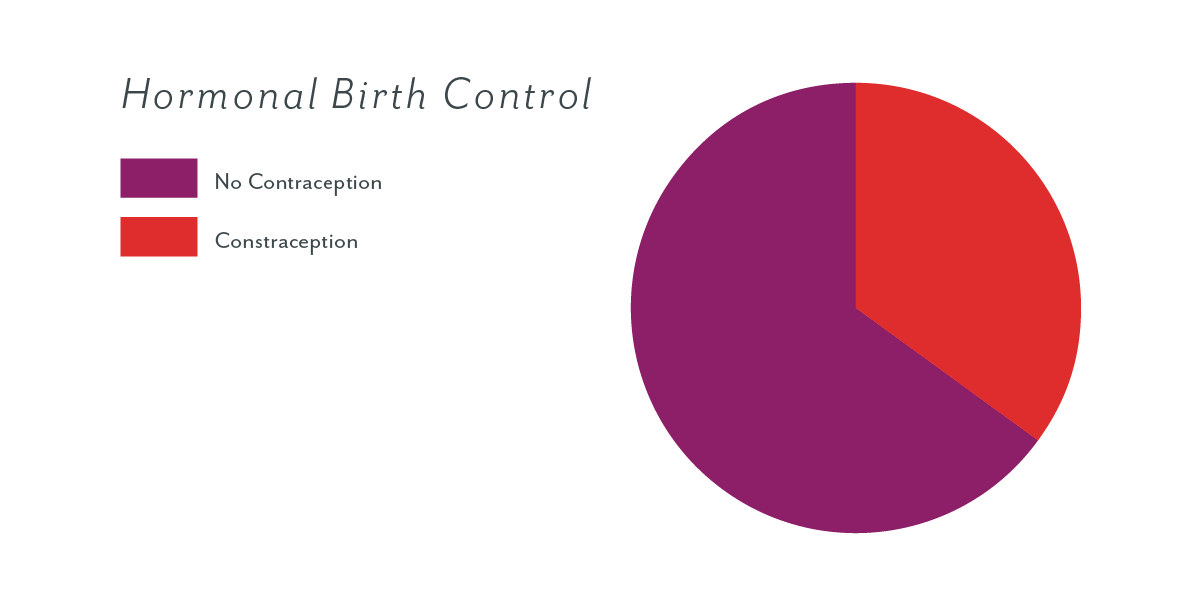Top menstrual cycle symptoms: Clue survey results
We recently sent out the first of many Clue Health Surveys to better understand symptoms people experience during their cycle.
The science is quite clear: certain symptoms happen at the same times every cycle. These symptoms can indicate the hormonal shifts and changes during the different cycle phases (the premenstrual/menstrual, follicular, ovulatory and luteal phase). The more regular a cycle is, the easier it is to detect a pattern. This does not usually apply to the 1 in 3 people with irregular cycles. Symptoms in an irregular cycle usually happen at inconsistent times. Some symptoms may be totally normal, while others may indicate a medical condition.
Over 4,000 people responded within the first week. Here are the results:
50% experience acne
Acne (acne vulgaris) is one of the most frequently reported skin ailments connected to your cycle (1). Period-related hormonal breakouts, known as catamenial acne, occur in the perimenstrual phase (the 10 days before and during your period). Progesterone leads to an overproduction of sebum (the skin’s oily secretion), which contributes to catamenial acne. Acne can also be closely connected to certain lifestyle factors (2). Some people see a reduction in acne breakouts when they take hormonal birth control. Acne is common during adolescence (3), and in people with polycystic ovary syndrome (PCOS)(4).
49% experience headache, dizziness, or lightheadedness
Headaches are a common symptom of the premenstrual phase (5). They may be caused by prostaglandins, which are hormone-like substances that help the uterus contract, to shed the uterine lining (6).
Migraines are influenced by the menstrual cycle, and may be a symptom of the premenstrual phase for some people (7). Migraines are intense headaches that can be accompanied by pulsating pain, sensitivity to light and noise, nausea and/or vomiting. Some people experience migraine auras, which are feelings, smells or lights felt shortly before a migraine itself. Some people also report that their migraines change throughout their reproductive lifespan. This means a migraine might feel different in relation to someone’s first period, oral contraceptive use, pregnancy and/or menopause. Changing estrogen levels are believed to cause these changes. Taking extra estrogen (as hormonal birth control or hormonal replacement therapy) may make migraines worse (8).
Sudden hormonal changes experienced right before the period, as well as during the ovulatory phase, can cause lightheadedness and/or dizziness (9). Anemia (a low red blood cell count) can also cause dizziness and headaches (10).
40% experience fatigue
Fatigue is frequently brought up in the context of the menstrual cycle and is a commonly reported symptom of PMS (11). Fatigue is also frequently reported during adolescence, pregnancy, the postpartum period and menopause (12–15). Long term exhaustion can be a sign of a medical condition like endometriosis, a thyroid disorder or less commonly, polycystic ovary syndrome (PCOS) (16,17). Anemia and diabetes can also cause fatigue (10, 18).
39% experience cold hands and feet
Cold hands and feet is the most common sign of an underactive thyroid gland (19). It can also be caused by anemia (10).
37% experience backache and/or leg pains
Cramps are a common pain symptom in the days before and during menstruation. Painful cramping is also sometimes felt in the lower back and thighs (20). Lower back pain, as well as leg pain, is often experienced during pregnancy (21) and in people with endometriosis (22).
35% experience chronic pelvic pain
Chronic pelvic pain (CPP) is a common complaint people bring to their healthcare providers. This symptom is most commonly caused by endometriosis, fibroids and polyps (23).
26% experience diarrhea and/or nausea
Some people experience nausea as a premenstrual symptom. Nausea is also common during early pregnancy. Overeating, food allergies, food poisoning, indigestion, stomach flu and anxiety may also cause nausea. Some people report nausea as a side effect of certain medications and oral contraceptives (24).
Diarrhea is the most common gastrointestinal symptom reported before and during the period (25). High levels of contraction-causing substances called prostaglandins are thought to be the cause of diarrhea before and during the period (26).
22% experience constipation
Constipation is a common and painful condition. Diet, stress and physical activity affect bowel movements and can contribute to constipation. Some people report constipation before and during the period (27, 11). Constipation is common during pregnancy, and can also be caused by conditions like endometriosis or thyroid disorder (28, 29).
18% experience painful bowel movements
A recent study showed that more than 70% of individuals experience at least one gastrointestinal (GI) symptom before and during the period (11). The most common cause of painful bowel movements throughout the menstrual cycle is endometriosis. Polycystic ovary syndrome (PCOS) might make painful bowel movements worse around the time of the period (30, 31).
18% experience brittle nails and/or hair loss
Brittle nails can be caused by dehydration, nutritional deficiencies (minerals and amino acids), certain medications or injuries to the base of the nail. Environmental factors (climate) can also cause nails to be dehydrated and brittle (32). Hair loss is almost always caused by a hormonal imbalance, but can also stem from harsh chemical hair treatments (33).
Individuals suffering from polycystic ovary syndrome (PCOS) often experience hair loss (androgenic alopecia) (34). Thyroid disorders can also cause brittle nails and hair loss (alopecia) (35).
17% experience pale skin
Heavy menstrual bleeding, anemia and hypothyroidism can all cause pale skin (10,34).
15% experience fast heartbeat and/or shortness of breath
Anemia can cause shortness of breath (10). Thyroid disorders, and the medications that manage them, might cause a rapid heartbeat and shortness of breath (34).
13% experience watery, bloody or foul smelling vaginal discharge
Watery, bloody or foul smelling vaginal discharge can be due to many things like certain medications, infections or allergies (36, 37). This discharge can vary in texture (e.g. chunky, foamy), smell (e.g. foul, fishy) or color (e.g. green).
Discharge that is bloody or accompanied by a fever and/or abdominal pain may be a sign of a sexually transmitted infection or urinary tract infection, and should be treated as an emergency (38).
13% experience frequent urination and/or difficulty urinating
The most common causes of frequent urination and/or difficulty urinating are bladder infections, sexually transmitted infections, endometriosis and diabetes (39, 40).
13% experience excessive hair growth
Individuals suffering from polycystic ovary syndrome (PCOS) often experience dermatological problems such as excessive hair growth (hirsutism) on the face, back and belly (4).
12% experience chest pain
The most common causes of chest pain are muscular or joint problems, but chest pain may also be caused by anemia and endometriosis (10, 41, 42).
10% experience pain and/or bleeding during or after sexual intercourse
Pain and/or bleeding during or after sex (not related to menstruation) occurs in 0.7% to 9% of menstruating people. These symptoms may be mechanical damage to the cervix or by conditions such as polyps, fibroids and endometriosis (43).
42% struggle with weight
As you grow and age, your body weight will change. It may also change through periods of increased or decreased physical activity, illness or pregnancy. Weight changes might be noticed during adolescence or menopause. Conditions such as PCOS, diabetes and thyroid disorders have a strong impact on weight fluctuations (44–46).

10% have a diagnosed condition

The most common symptoms of PCOS are:
Acne, excessive hair growth, weight gain and irregular cycles
The most common symptoms of thyroid disorders are:
Chronic pelvic pain, cold hands and feet and sudden weight changes
The most common symptoms of endometriosis are:
Chronic pelvic pain, fatigue and painful bowel movements
The most common symptoms of diabetes are:
Headache, lightheadedness and dizziness, acne and weight gain
35% use hormonal contraception to regulate their cycle

Hormonal birth control (HBC) will help you manage many of the symptoms you experience because of your condition. Hormones in your HBC will help maintain the levels and ratios of hormones necessary for regular menstrual cycle function.
Many of these symptoms can indicate an irregular cycle if they happen often or without an obvious pattern. What causes irregular cycles?
Irregular cycles occur for many different reasons. The most common cause is simply transitioning through a different life stage: adolescence (when the first period happens) or pre-menopause (time when periods cease around age 45–55).
Some of the other causes include:
- Stress
- Excessive/extreme sports
- Poor diet
- Hormonal birth control or copper IUD
- Miscarriage
- Breastfeeding
- Polycystic ovary syndrome (PCOS)
- Endometriosis
- Uterine polyps
- Fibroids
- Problems with blood clothing (also called haemophilia)
The best way to determine the cause of your symptoms or irregularity is to talk to your healthcare provider. Tell them about your cycle (period and average cycle length) and symptoms. How debilitating are your symptoms? Do they affect your daily routine? Your healthcare provider might need to run a couple of additional tests to help with determining the root causes of your irregular cycles and symptoms.